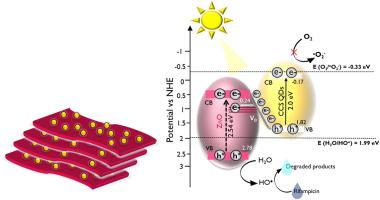当前位置:
X-MOL 学术
›
Environ. Pollut.
›
论文详情
Our official English website, www.x-mol.net, welcomes your feedback! (Note: you will need to create a separate account there.)
Enhanced visible light driven photodegradation of rifampicin and Cr(VI) reduction activity of ultra-thin ZnO nanosheets/CuCo2S4QDs: A mechanistic insights, degradation pathway and toxicity assessment
Environmental Pollution ( IF 8.9 ) Pub Date : 2024-03-14 , DOI: 10.1016/j.envpol.2024.123760 S. Sudheer Khan , S. Kokilavani , Tahani Awad Alahmadi , Mohammad Javed Ansari
Environmental Pollution ( IF 8.9 ) Pub Date : 2024-03-14 , DOI: 10.1016/j.envpol.2024.123760 S. Sudheer Khan , S. Kokilavani , Tahani Awad Alahmadi , Mohammad Javed Ansari

|
In this study, we focused on fabrication of porous ultra-thin ZnO nanosheet (PUNs)/CuCoS quantum dots (CCS QDs) for visible light-driven photodegradation of rifampicin (RIF) and Cr(VI) reduction. The morphology, structural, optical and textural properties of fabricated photocatalyst were critically analyzed with different analytical and spectroscopic techniques. An exceptionally high RIF degradation (99.97%) and maximum hexavalent Cr(VI) reduction (96.17%) under visible light was achieved at 10 wt% CCS QDs loaded ZnO, which is 213% and 517% greater than bare ZnO PUNs. This enhancement attributed to the improved visible light absorption, interfacial synergistic effect, and high surface-rich active sites. Extremely high generation of OH attributed to the spin-orbit coupling in ZnO PUNs@CCS QDs and the existence of oxygen vacancies. Besides, the ZnOPUNs@CCS QDs, forming Z-scheme heterojunctions, enhanced the separation of photogenerated charge carriers. We investigated the influencing factors such as pH, inorganic ions, catalyst dosage and drug dosage on the degradation process. More impressively, a stable performance of ZnO PUNs@CCS QDs obtained even after six consecutive degradation (85.9%) and Cr(VI) reduction (67.7%) cycles. Furthermore, the toxicity of intermediates produced during the photodegradation process were assessed using ECOSAR program. This work provides a new strategy for ZnO-based photocatalysis as a promising candidate for the treatment of various contaminants present in water bodies.
中文翻译:

增强可见光驱动的利福平光降解和超薄 ZnO 纳米片/CuCo2S4QD 的 Cr(VI) 还原活性:机理见解、降解途径和毒性评估
在这项研究中,我们重点研究了多孔超薄 ZnO 纳米片 (PUN)/CuCoS 量子点 (CCS QD) 的制造,用于可见光驱动的利福平 (RIF) 光降解和 Cr(VI) 还原。使用不同的分析和光谱技术对制造的光催化剂的形态、结构、光学和质地特性进行了严格的分析。 10 wt% CCS QD 负载 ZnO 时,在可见光下实现了极高的 RIF 降解(99.97%)和最大六价 Cr(VI) 还原(96.17%),比裸 ZnO PUN 分别高出 213% 和 517%。这种增强归因于可见光吸收的改善、界面协同效应和高表面丰富的活性位点。 ZnO PUNs@CCS QD 中的自旋轨道耦合和氧空位的存在导致了极高的 OH 生成。此外,ZnOPUNs@CCS QDs形成Z型异质结,增强了光生电荷载流子的分离。考察了pH、无机离子、催化剂用量、药物用量等对降解过程的影响因素。更令人印象深刻的是,即使在连续六次降解(85.9%)和六价铬还原(67.7%)循环后,ZnO PUNs@CCS QD 仍能获得稳定的性能。此外,使用ECOSAR程序评估了光降解过程中产生的中间体的毒性。这项工作为氧化锌基光催化提供了一种新策略,作为处理水体中存在的各种污染物的有希望的候选者。
更新日期:2024-03-14
中文翻译:

增强可见光驱动的利福平光降解和超薄 ZnO 纳米片/CuCo2S4QD 的 Cr(VI) 还原活性:机理见解、降解途径和毒性评估
在这项研究中,我们重点研究了多孔超薄 ZnO 纳米片 (PUN)/CuCoS 量子点 (CCS QD) 的制造,用于可见光驱动的利福平 (RIF) 光降解和 Cr(VI) 还原。使用不同的分析和光谱技术对制造的光催化剂的形态、结构、光学和质地特性进行了严格的分析。 10 wt% CCS QD 负载 ZnO 时,在可见光下实现了极高的 RIF 降解(99.97%)和最大六价 Cr(VI) 还原(96.17%),比裸 ZnO PUN 分别高出 213% 和 517%。这种增强归因于可见光吸收的改善、界面协同效应和高表面丰富的活性位点。 ZnO PUNs@CCS QD 中的自旋轨道耦合和氧空位的存在导致了极高的 OH 生成。此外,ZnOPUNs@CCS QDs形成Z型异质结,增强了光生电荷载流子的分离。考察了pH、无机离子、催化剂用量、药物用量等对降解过程的影响因素。更令人印象深刻的是,即使在连续六次降解(85.9%)和六价铬还原(67.7%)循环后,ZnO PUNs@CCS QD 仍能获得稳定的性能。此外,使用ECOSAR程序评估了光降解过程中产生的中间体的毒性。这项工作为氧化锌基光催化提供了一种新策略,作为处理水体中存在的各种污染物的有希望的候选者。



























 京公网安备 11010802027423号
京公网安备 11010802027423号